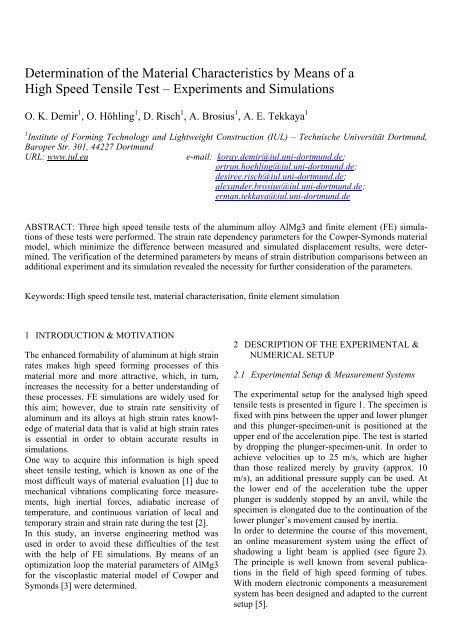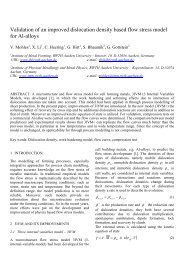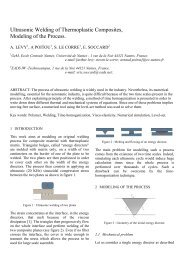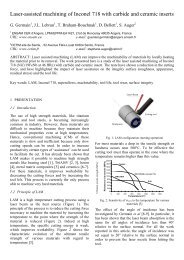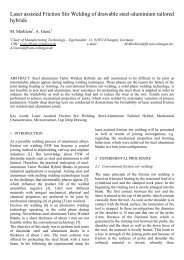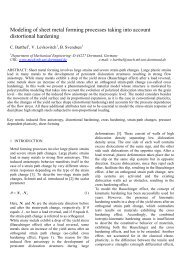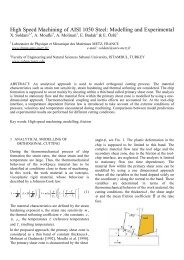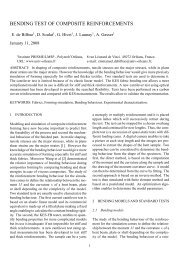Determination of the material characteristics by means of a high ...
Determination of the material characteristics by means of a high ...
Determination of the material characteristics by means of a high ...
Create successful ePaper yourself
Turn your PDF publications into a flip-book with our unique Google optimized e-Paper software.
<strong>Determination</strong> <strong>of</strong> <strong>the</strong> Material Characteristics <strong>by</strong> Means <strong>of</strong> a<br />
High Speed Tensile Test – Experiments and Simulations<br />
O. K. Demir 1 , O. Höhling 1 , D. Risch 1 , A. Brosius 1 , A. E. Tekkaya 1<br />
1 Institute <strong>of</strong> Forming Technology and Lightweight Construction (IUL) – Technische Universität Dortmund,<br />
Baroper Str. 301, 44227 Dortmund<br />
URL: www.iul.eu<br />
e-mail: koray.demir@iul.uni-dortmund.de;<br />
ortrun.hoehling@iul.uni-dortmund.de;<br />
desiree.risch@iul.uni-dortmund.de;<br />
alexander.brosius@iul.uni-dortmund.de;<br />
erman.tekkaya@iul.uni-dortmund.de<br />
ABSTRACT: Three <strong>high</strong> speed tensile tests <strong>of</strong> <strong>the</strong> aluminum alloy AlMg3 and finite element (FE) simulations<br />
<strong>of</strong> <strong>the</strong>se tests were performed. The strain rate dependency parameters for <strong>the</strong> Cowper-Symonds <strong>material</strong><br />
model, which minimize <strong>the</strong> difference between measured and simulated displacement results, were determined.<br />
The verification <strong>of</strong> <strong>the</strong> determined parameters <strong>by</strong> <strong>means</strong> <strong>of</strong> strain distribution comparisons between an<br />
additional experiment and its simulation revealed <strong>the</strong> necessity for fur<strong>the</strong>r consideration <strong>of</strong> <strong>the</strong> parameters.<br />
Keywords: High speed tensile test, <strong>material</strong> characterisation, finite element simulation<br />
1 INTRODUCTION & MOTIVATION<br />
The enhanced formability <strong>of</strong> aluminum at <strong>high</strong> strain<br />
rates makes <strong>high</strong> speed forming processes <strong>of</strong> this<br />
<strong>material</strong> more and more attractive, which, in turn,<br />
increases <strong>the</strong> necessity for a better understanding <strong>of</strong><br />
<strong>the</strong>se processes. FE simulations are widely used for<br />
this aim; however, due to strain rate sensitivity <strong>of</strong><br />
aluminum and its alloys at <strong>high</strong> strain rates knowledge<br />
<strong>of</strong> <strong>material</strong> data that is valid at <strong>high</strong> strain rates<br />
is essential in order to obtain accurate results in<br />
simulations.<br />
One way to acquire this information is <strong>high</strong> speed<br />
sheet tensile testing, which is known as one <strong>of</strong> <strong>the</strong><br />
most difficult ways <strong>of</strong> <strong>material</strong> evaluation [1] due to<br />
mechanical vibrations complicating force measurements,<br />
<strong>high</strong> inertial forces, adiabatic increase <strong>of</strong><br />
temperature, and continuous variation <strong>of</strong> local and<br />
temporary strain and strain rate during <strong>the</strong> test [2].<br />
In this study, an inverse engineering method was<br />
used in order to avoid <strong>the</strong>se difficulties <strong>of</strong> <strong>the</strong> test<br />
with <strong>the</strong> help <strong>of</strong> FE simulations. By <strong>means</strong> <strong>of</strong> an<br />
optimization loop <strong>the</strong> <strong>material</strong> parameters <strong>of</strong> AlMg3<br />
for <strong>the</strong> viscoplastic <strong>material</strong> model <strong>of</strong> Cowper and<br />
Symonds [3] were determined.<br />
2 DESCRIPTION OF THE EXPERIMENTAL &<br />
NUMERICAL SETUP<br />
2.1 Experimental Setup & Measurement Systems<br />
The experimental setup for <strong>the</strong> analysed <strong>high</strong> speed<br />
tensile tests is presented in figure 1. The specimen is<br />
fixed with pins between <strong>the</strong> upper and lower plunger<br />
and this plunger-specimen-unit is positioned at <strong>the</strong><br />
upper end <strong>of</strong> <strong>the</strong> acceleration pipe. The test is started<br />
<strong>by</strong> dropping <strong>the</strong> plunger-specimen-unit. In order to<br />
achieve velocities up to 25 m/s, which are <strong>high</strong>er<br />
than those realized merely <strong>by</strong> gravity (approx. 10<br />
m/s), an additional pressure supply can be used. At<br />
<strong>the</strong> lower end <strong>of</strong> <strong>the</strong> acceleration tube <strong>the</strong> upper<br />
plunger is suddenly stopped <strong>by</strong> an anvil, while <strong>the</strong><br />
specimen is elongated due to <strong>the</strong> continuation <strong>of</strong> <strong>the</strong><br />
lower plunger’s movement caused <strong>by</strong> inertia.<br />
In order to determine <strong>the</strong> course <strong>of</strong> this movement,<br />
an online measurement system using <strong>the</strong> effect <strong>of</strong><br />
shadowing a light beam is applied (see figure 2).<br />
The principle is well known from several publications<br />
in <strong>the</strong> field <strong>of</strong> <strong>high</strong> speed forming <strong>of</strong> tubes.<br />
With modern electronic components a measurement<br />
system has been designed and adapted to <strong>the</strong> current<br />
setup [5].
adapted measurement devices will be <strong>the</strong> input as<br />
well as reference for <strong>the</strong> numerical analysis.<br />
2.2 Numerical Setup<br />
Fig. 1 Experimental setup and measurement systems<br />
The system consists <strong>of</strong> a laser beam which is expanded<br />
to a line, parallelized <strong>by</strong> a lens, and received<br />
<strong>by</strong> a so called Position Sensitive Device (PSD). During<br />
<strong>the</strong> deformation process <strong>the</strong> lower plunger<br />
moves between laser and receiver, partly shadowing<br />
<strong>the</strong> laser light so that <strong>the</strong> quantity <strong>of</strong> light changes<br />
directly proportional to <strong>the</strong> displacement <strong>of</strong> <strong>the</strong><br />
lower plunger.<br />
Fig. 2 Principle <strong>of</strong> Laser-PSD<br />
An additional measurement facility (see figure 1),<br />
which is adapted to <strong>the</strong> testing device, is <strong>the</strong> <strong>high</strong><br />
speed camera HSFC.pro (company PCO, Germany).<br />
This camera is able to take eight pictures within a<br />
variable time interval reaching from a tenth <strong>of</strong> a microsecond<br />
to seconds. Figure 6 shows a series <strong>of</strong><br />
four pictures from <strong>the</strong> whole sequence. Fur<strong>the</strong>rmore,<br />
a stochastic pattern can be recognized which is necessary<br />
in order to do a strain analysis with <strong>the</strong><br />
Aramis system developed <strong>by</strong> <strong>the</strong> GOM company [6].<br />
The last adapted measurement device is a light barrier<br />
which is integrated in <strong>the</strong> acceleration pipe in<br />
order to trigger <strong>the</strong> <strong>high</strong> speed camera. Additionally,<br />
using again <strong>the</strong> effect <strong>of</strong> shadowing a light beam, it<br />
is possible to determine <strong>the</strong> fall velocity <strong>of</strong> <strong>the</strong><br />
plunger-specimen-unit. The experimental data <strong>of</strong> all<br />
The FE simulations were performed using <strong>the</strong> dynamic<br />
explicit three dimensional solver <strong>of</strong> <strong>the</strong> commercial<br />
code LS-DYNA, employing brick-shaped<br />
elements with eight nodes, single integration point,<br />
and hourglass control.<br />
The necessity for <strong>the</strong> dynamic calculation arises<br />
from <strong>the</strong> fact that <strong>the</strong> transit times for <strong>the</strong> stress<br />
waves travelling along <strong>the</strong> specimen are long with<br />
respect to <strong>the</strong> duration <strong>of</strong> <strong>the</strong> application <strong>of</strong> tensile<br />
forces. During <strong>the</strong> experiments <strong>the</strong> fracture <strong>of</strong> <strong>the</strong><br />
specimen occurs in certain cases after approx.<br />
300 μs, while a mechanical wave travels back and<br />
forth along <strong>the</strong> specimen in 24 μs, which <strong>means</strong> that<br />
a stress wave moves back and forth only 12 times<br />
during <strong>the</strong> whole test. This prevents <strong>the</strong> equilibrium<br />
<strong>of</strong> forces in <strong>the</strong> specimen from evolving and makes a<br />
static assumption useless.<br />
The assumption <strong>of</strong> linear elastic <strong>material</strong> behaviour<br />
was made for <strong>the</strong> pins, while <strong>the</strong> viscoplastic constitutive<br />
model developed <strong>by</strong> Cowper and Symonds<br />
was used for <strong>the</strong> plastic deformation <strong>of</strong> <strong>the</strong> specimen,<br />
neglecting <strong>the</strong> effect <strong>of</strong> adiabatic heating. This<br />
model is selected based on <strong>the</strong> low number <strong>of</strong> variables,<br />
which <strong>means</strong> a reduced number <strong>of</strong> simulations<br />
during <strong>the</strong> optimization loops. The application <strong>of</strong> <strong>the</strong><br />
Cowper-Symonds model in LS-DYNA requires <strong>the</strong><br />
elastic constants and <strong>the</strong> quasi-static (q-s) flow curve<br />
<strong>of</strong> <strong>the</strong> <strong>material</strong> and scales <strong>the</strong> given flow stress values<br />
with a factor calculated <strong>by</strong> eq. (1) given below:<br />
⎛ ε ⎞<br />
Scale factor = 1+ ⎜ ⎟<br />
⎝C<br />
⎠<br />
1<br />
p<br />
, (1)<br />
where ε is <strong>the</strong> strain rate and C and p are <strong>the</strong><br />
Cowper-Symonds strain rate parameters. The q-s<br />
flow curve <strong>of</strong> AlMg3 for <strong>the</strong> simulations was obtained<br />
<strong>by</strong> a conventional tension test.<br />
A representative mesh <strong>of</strong> <strong>the</strong> specimen and <strong>the</strong> dimensions<br />
<strong>of</strong> <strong>the</strong> model can be seen in figure 3.<br />
46,000 elements have been used for <strong>the</strong> numerical<br />
model <strong>of</strong> <strong>the</strong> specimen. The front pin is attached to a<br />
point mass, which represents <strong>the</strong> lower plunger.<br />
While <strong>the</strong> whole model (specimen, pins, and <strong>the</strong><br />
plunger) has a certain initial velocity in x-direction,<br />
<strong>the</strong> nodes in <strong>the</strong> front region <strong>of</strong> <strong>the</strong> back pin are constrained<br />
in x-direction, which represents <strong>the</strong> impact<br />
between <strong>the</strong> back pin and <strong>the</strong> plunger that occurs
when <strong>the</strong> plunger stops suddenly.<br />
In order to simulate a given experiment, <strong>the</strong> velocity<br />
<strong>of</strong> <strong>the</strong> plunger-specimen unit just before <strong>the</strong> impact<br />
needs to be measured. This velocity is transferred to<br />
<strong>the</strong> FE simulation as an initial condition. The outputs<br />
<strong>of</strong> <strong>the</strong> simulation and experiment can be compared<br />
considering <strong>the</strong> displacement course <strong>of</strong> <strong>the</strong> lower<br />
plunger.<br />
3 RESULTS<br />
3.1 Course <strong>of</strong> Plunger Displacement<br />
Figure 4 reveals <strong>the</strong> experiment results and simulation<br />
results when C=p=0 (q-s flow curve is used)<br />
and when C=850 and p=0.03.<br />
Fig. 3 FE model<br />
2.3 <strong>Determination</strong> <strong>of</strong> <strong>the</strong> Material Parameters<br />
In order to determine <strong>the</strong> C-p couple equating <strong>the</strong><br />
displacement results <strong>of</strong> a simulation to <strong>the</strong> corresponding<br />
experiment, first, two simulations were<br />
performed with two initial guesses <strong>of</strong> <strong>the</strong> C-p couple.<br />
The following guesses were calculated <strong>by</strong> a simplex-based<br />
optimization algorithm developed <strong>by</strong><br />
Nelder and Mead [4] until <strong>the</strong> objective function<br />
given below is minimized:<br />
2<br />
f( C, p) = ∑ ( uexp<br />
⋅uexp<br />
−usim<br />
⋅u sim)<br />
, (2)<br />
where u and u represent <strong>the</strong> displacement and velocity<br />
<strong>of</strong> <strong>the</strong> lower plunger and subscripts “exp” and<br />
“sim” stand for experiment and simulation, respectively.<br />
The objective function was evaluated <strong>by</strong> taking<br />
only experimental data until fracture into account.<br />
There can be more than one C-p couple that makes a<br />
simulation result coincident with <strong>the</strong> corresponding<br />
measurement. Fur<strong>the</strong>rmore, <strong>the</strong> C-p couple determined<br />
for an experiment depends on <strong>the</strong> initial<br />
guesses supplied <strong>by</strong> <strong>the</strong> user and it is not necessarily<br />
valid for o<strong>the</strong>r experiments performed at different<br />
velocities. Here, our aim was to determine a C-p<br />
couple valid for all experiments at hand. The reliability<br />
<strong>of</strong> <strong>the</strong> determined couple is directly proportional<br />
to <strong>the</strong> number <strong>of</strong> experiment-simulation pairs<br />
taken into account during <strong>the</strong> optimization process.<br />
For this study, three experiments were performed at:<br />
11.4 m/s, 15.9 m/s, and 22.6 m/s.<br />
Fig. 4 Measured and calculated plunger displacement courses<br />
When <strong>the</strong> tests were simulated using <strong>the</strong> q-s flow<br />
curve <strong>of</strong> <strong>the</strong> <strong>material</strong>, <strong>the</strong> simulations overestimated<br />
<strong>the</strong> measured displacements <strong>of</strong> <strong>the</strong> lower plunger<br />
severely, as expected. The utilization <strong>of</strong> <strong>the</strong> mentioned<br />
C-p couple reduced <strong>the</strong> maximum error values<br />
until fracture to 5.9%, 1.9%, and 4.3% for <strong>the</strong><br />
cases <strong>of</strong> 11.4 m/s, 15.9 m/s, and 22.6 m/s initial velocities,<br />
respectively.<br />
As can be seen in figure 5, with <strong>the</strong>se parameters <strong>the</strong><br />
<strong>material</strong> gains a very strong strain rate dependency.<br />
The parameter p decides <strong>the</strong> sensitivity <strong>of</strong> <strong>the</strong> scale<br />
factor to strain rate. A very small value, as <strong>the</strong> one<br />
found, leads to an extreme sensitivity and very large<br />
scale factors above a strain rate <strong>of</strong> 880 s -1 . The importance<br />
<strong>of</strong> <strong>the</strong> factor C arises at this point: it determines<br />
this critical strain rate value, above which <strong>the</strong><br />
calculated scale factors are very large. Hence, for<br />
small values <strong>of</strong> p <strong>the</strong> scale factor is also very sensitive<br />
to C, which is ano<strong>the</strong>r disadvantage <strong>of</strong> <strong>the</strong> determined<br />
parameter couple.<br />
Fig. 5 Scale factor with respect to strain rate and p
3.2 Course <strong>of</strong> Strain Distribution<br />
In order to validate <strong>the</strong> determined <strong>material</strong> parameters,<br />
an additional experiment with a velocity <strong>of</strong><br />
9.2 m/s, which is outside <strong>the</strong> range <strong>of</strong> <strong>the</strong> o<strong>the</strong>r three<br />
velocities, was carried out and eight pictures were<br />
taken using <strong>the</strong> <strong>high</strong> speed camera. Four representative<br />
photos are given in figure 6.<br />
The elongation at fracture measured after <strong>the</strong> experiment<br />
was 4 mm. Since <strong>the</strong> <strong>high</strong> speed camera<br />
and <strong>the</strong> displacement measurement setup cannot be<br />
used simultaneously <strong>the</strong> according time period must<br />
be approximated. According to an extrapolation <strong>of</strong><br />
previous experiment results, a duration <strong>of</strong> 600 μs<br />
was estimated. Thus, <strong>the</strong> time at figure 6c was assumed<br />
to be 600 µs due to <strong>the</strong> occurring fracture.<br />
Knowing <strong>the</strong> time period between two photos being<br />
100 μs, <strong>the</strong> time for all <strong>the</strong> photos can be deduced.<br />
Fig. 6 Photos from a <strong>high</strong> speed tensile test. a) initial state, b)<br />
elongation, c) fracture, and d) <strong>the</strong> state after <strong>the</strong> fracture<br />
Next, <strong>the</strong> strain distribution on <strong>the</strong> surface <strong>of</strong> <strong>the</strong><br />
specimen along <strong>the</strong> centreline was analysed using<br />
<strong>the</strong> Aramis system and <strong>the</strong> results were compared to<br />
<strong>the</strong> simulations. Figure 7 shows <strong>the</strong> comparison.<br />
t=500 μs in <strong>the</strong> necking region. These changes make<br />
<strong>the</strong> simulation results resemble <strong>the</strong> experimental<br />
results qualitatively, but <strong>the</strong> strain evolution, obvious<br />
in <strong>the</strong> experiment data, cannot be acquired in <strong>the</strong><br />
simulation.<br />
This can be explained <strong>by</strong> errors in measuring <strong>the</strong><br />
initial specimen velocity, measuring strains, or approximating<br />
<strong>the</strong> moments, when <strong>the</strong> photos were<br />
taken. It might also indicate that <strong>the</strong> Cowper-<br />
Symonds model or <strong>the</strong> determined parameters are<br />
unsuitable for modelling <strong>the</strong> behaviour <strong>of</strong> AlMg3.<br />
4 SUMMARY<br />
A combined experimental and numerical approach<br />
for determining <strong>the</strong> <strong>material</strong> behaviour <strong>of</strong> AlMg3 at<br />
<strong>high</strong> strain rates was tested. Therefore, a <strong>high</strong> speed<br />
tensile test including several measurement systems<br />
was realized. FE simulations were carried out in<br />
order to find <strong>the</strong> Cowper-Symonds <strong>material</strong> constants<br />
<strong>by</strong> <strong>means</strong> <strong>of</strong> an inverse analysis. The determined<br />
constants are pretty successful in predicting<br />
experimental displacements, but <strong>the</strong> strain results<br />
need more consideration. Applying <strong>the</strong> same methodology<br />
with more experiments, or verifying <strong>the</strong><br />
used <strong>material</strong> model or measurement techniques are<br />
conceivable alternatives for fur<strong>the</strong>r research.<br />
ACKNOWLEDGEMENTS<br />
The authors would like to thank <strong>the</strong> German Research Foundation<br />
(DFG) for its financial support <strong>of</strong> <strong>the</strong> work reported here,<br />
acquired within <strong>the</strong> scope <strong>of</strong> Research Unit FOR 443.<br />
Fig. 7 Strain distribution courses. a) experiment results, b)<br />
trendlines <strong>of</strong> experiment results, c) simulation results (C=p=0),<br />
d) simulation results (C=880, p=0.03)<br />
Applying <strong>the</strong> parameters prevents strain localization<br />
that takes place at t=300 μs around x=1, and later at<br />
REFERENCES<br />
1. P. Larour, A. Rusinek, J.R. Klepaczko and W. Bleck,<br />
‘Effects <strong>of</strong> Strain Rate and Identification <strong>of</strong> Material<br />
Constants for Three Automative Steels’, Steel Research<br />
Int., 78, (2007) 348-358<br />
2. M. Kleiner and A. Brosius, ‘<strong>Determination</strong> <strong>of</strong> Flow<br />
Curves at High Strain Rates using <strong>the</strong> Electromagnetic<br />
Forming Process and an Iterative Finite Element Simulation<br />
Scheme’, CIRP Annals - Manufacturing Technology,<br />
55, (2006) 267-270<br />
3. P.S. Symonds, ‘Survey <strong>of</strong> Methods <strong>of</strong> Analysis for plastic<br />
deformation <strong>of</strong> structures under dynamic loading’,<br />
Technical Report, Brown University, 1967<br />
4. J.A. Nelder, R. Mead, ‘A Simplex Method for Function<br />
Minimization’, Computer Journal, 7, (1965) 308-313<br />
5. M. Badelt, C. Beerwald, A. Brosius and M. Kleiner,<br />
Process Analysis <strong>of</strong> Electromagnetic Sheet Metal Forming<br />
<strong>by</strong> Online-Measurement and Finite Element Simulation.<br />
Proc. <strong>of</strong> <strong>the</strong> 6th ESAFORM, 2003, 123-126<br />
6. www.gom.com


